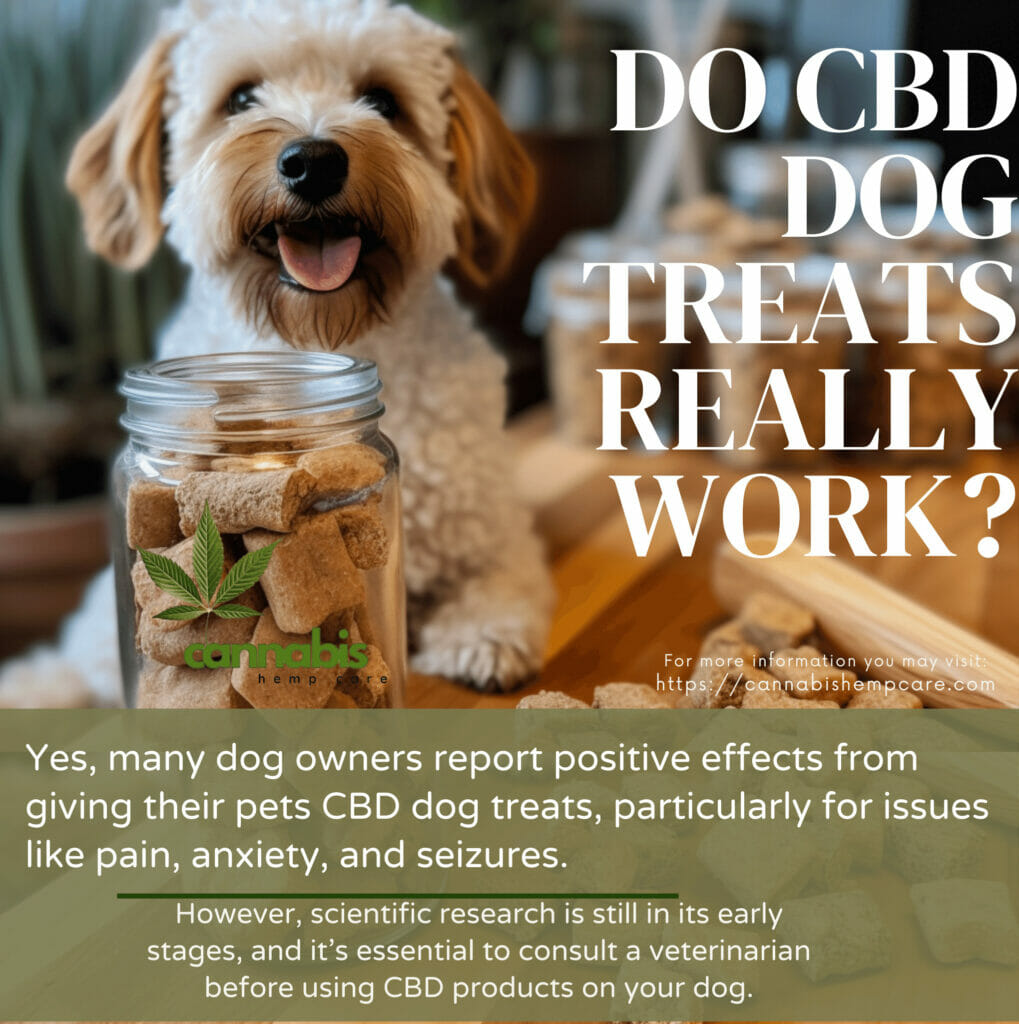With the rise of holistic health trends for humans, it’s no surprise that treatments like CBD have found their way into the pet market. For dog owners, the big question is: Do CBD dog treats work? In this beginner-friendly guide, we’ll delve into the current research surrounding CBD for dogs, its potential benefits, and what experts are saying.
What Is CBD?
CBD, an abbreviation for cannabidiol, stands as a remarkable natural compound hailing predominantly from the lush expanse of hemp plants. In sharp contrast to its close counterpart THC, notorious for inducing the euphoric ‘high’ in marijuana, CBD holds a distinctly non-psychoactive demeanor.
This means that contrary to the mind-altering effects of THC, CBD won’t elicit any altered states of consciousness or leave your beloved pet feeling ‘high.’ Instead, CBD offers a different kind of therapeutic potential, making it a focal point of curiosity and research within the world of pet wellness..
Do CBD Dog Treats Really Work?
Yes, many dog owners report positive effects from giving their pets CBD dog treats, particularly for issues like pain, anxiety, and seizures. However, scientific research is still in its early stages, and it’s essential to consult a veterinarian before using CBD products on your dog.

- Pain and Inflammation: Many pet enthusiasts are exploring CBD for its potential role in alleviating inflammation-related pain. While comprehensive studies focusing on canines are still in the works, human-based research has provided insights.
For instance, a study from the European Journal of Pain revealed that topical CBD application reduced arthritis-induced pain and inflammation. Dog owners, through personal experiences, have often reported parallel benefits for their pets. - Anxiety: Another common use of CBD for dogs is in managing anxiety. Dogs can experience anxiety due to various reasons, from separation from their owners to loud noises like fireworks.
While there isn’t substantial scientific literature on CBD’s effects on dog anxiety, a study published in The Permanente Journal on humans showed that CBD could help reduce anxiety in individuals with sleep disorders. - Seizures: Seizure control is one area where there’s growing research concerning CBD’s benefits for dogs. A study conducted at Colorado State University’s College of Veterinary Medicine, published in the Journal of the American Veterinary Medical Association, found that 89% of dogs who received CBD in a clinical trial had a reduction in the frequency of seizures.
- Safety and Side Effects: Like any supplement or medication, CBD is not without potential side effects. The most commonly reported side effects in dogs include dry mouth, lowered blood pressure, and drowsiness. Ensuring the right dosage and ensuring the product does not contain THC, which can be harmful to dogs, is crucial.
- Product Quality: It’s worth noting that the CBD market has a wide range of products, some of which may not be of high quality. A study by the Journal of the American Medical Association found that over 60% of online CBD products were mislabeled, indicating a significant concern about product purity and potency.
Anecdotal evidence suggests the benefits of CBD dog treats, and some studies are promising, more rigorous, large-scale research is needed. Always consult with a veterinarian before introducing CBD into your dog’s regimen and ensure you’re sourcing high-quality products from reputable sources.

Understanding Bioavailability
- Definition: Bioavailability refers to the proportion of CBD that, upon intake or application, reaches the bloodstream and is therefore made available for the body’s use. This concept is crucial as it determines how much of the CBD you’re administering is genuinely being utilized by your dog’s body.
- Real-world Analogy: It’s like pouring water into a sieve; not all the water you pour will end up in the container below. Similarly, not all the CBD given gets absorbed into the bloodstream.
Methods of Administration:
- Ingestion (like treats): Easily integrated into a dog’s diet but passes through the digestive system, leading to potential degradation by liver enzymes.
- Oils: Administered sublingually for faster absorption, often resulting in higher bioavailability and quicker effects.
- Capsules: Provide consistent and precise dosages but also undergo the digestive process.
- Topical balms: Externally applied, ideal for localized problems but may not be as effective for systemic or internal issues.

Importance of Proper Storage
CBD’s potency and safety are maintained with proper storage.
- Factors to Consider: Protect from direct sunlight, avoid moisture to prevent mold, especially in balms, and ensure a consistently cool temperature.
Concerns Related to Shelf Life
CBD’s efficacy can decline over time.
- Monitoring: Check expiration dates and observe any changes in smell, color, or texture.
Cost and Economic Considerations
- Considerations: Price hinges on the hemp quality, extraction methods, and company branding. Ensure you’re getting genuine quality, not just paying for marketing.
Assessing Long-term Investment
- Overview: Regular dosing for chronic conditions means an ongoing cost.
- Evaluation: Consider the long-term costs against potential benefits, veterinarian bills, and alternative treatments.
Hemp’s Agricultural Footprint
- Hemp Benefits: A sustainable crop requiring fewer pesticides and conserving soil nutrients. However, without proper management, it can strain the land.
- Hemp vs. Marijuana: Hemp is more common for CBD pet products due to its low THC content and is generally less resource-intensive than marijuana.
Promoting Sustainable Production
- Brands’ Initiatives: Many opt for sustainable methods, from organic farming to eco-friendly packaging.
- Conscious Purchasing: Environmentally-minded pet owners should seek out brands that prioritize sustainable practices.
With these detailed sections and headings, pet owners can navigate through the complexities of CBD products for their pets with greater clarity.
Expert Opinions
Veterinarians and pet experts are diving deep into the world of CBD. While many believe in its potential benefits, the consensus is that more research is essential. Dr. Emily Jenkins, a leading veterinarian, says, “The early results are promising. However, as with any new treatment, careful dosing and monitoring are crucial.”
How Do You Choose a Good CBD Treat?
If you’re considering CBD for your canine companion, ensure you’re selecting the right product:
- Source of CBD: Always opt for treats that use CBD derived from organically grown hemp.
- Third-party Testing: Ensure the product has been tested by a third-party lab for purity and potency.
- Check the Ingredients: Some treats contain unnecessary fillers or harmful additives. It’s best to go for natural and organic ingredients.
Dosage: How Much is Enough?
The appropriate CBD dosage can vary based on your dog’s size, weight, and specific health concerns. Always start with the recommended dose on the product label and monitor your dog’s response. Consulting with a veterinarian can offer personalized guidance.

Conclusion
In the ever-evolving realm of pet care, CBD dog treats stand as an intriguing intersection of natural wellness and scientific exploration. As pet owners tread this new terrain, it becomes imperative to prioritize transparency, lab-validated authenticity, and ethical sourcing. With the market awash with products, discernment is key.
Harnessing the potential of CBD entails sifting through the cacophony of marketing claims to unearth genuinely beneficial solutions. As guardians of our canine companions, an informed, cautious approach—tempered by robust scientific backing and ethical production practices—will ensure that the therapeutic promise of CBD isn’t compromised by hasty decisions or subpar products.
FAQs
How long does it take for CBD treats to start working in dogs?
It typically takes 30-45 minutes for CBD treats to begin showing effects in dogs. Generally, oils might manifest their effects slightly quicker than treats because they have fewer components that need digestion. However, both forms are effective.
Are CBD treats beneficial for calming dogs?
Yes, CBD has demonstrated potential in alleviating arthritis-related pain and enhancing joint mobility in dogs. Furthermore, it can potentially mitigate stress and anxiety symptoms in canines.
Can CBD dog treats cause drowsiness in pets?
Yes, drowsiness can occur as a side effect if a dog is administered an inappropriate amount of CBD. Proper dosage is essential to avoid such effects.
How often should CBD treats be given to dogs?
For pain management, it’s advisable to administer CBD to your dog every 8 hours or as necessary. For other purposes, a once or twice-daily regimen is recommended.
Will CBD treats stimulate appetite in dogs?
CBD can positively influence a dog’s appetite. By addressing inflammation, pain, stress, and anxiety, CBD can foster a better sense of well-being, making dogs more inclined to eat.




































